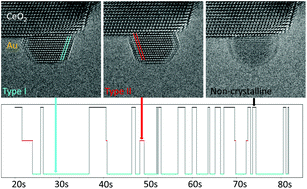Transformations of supported gold nanoparticles observed by in situ electron microscopy†
Abstract
Oxide supported metal nanoparticles play an important role in heterogeneous catalysis. However, understanding the metal/oxide interface and their evolution under reaction conditions remains challenging. Herein, we investigate the interface between Au nanoparticles and a CeO2 substrate by environmental transmission electron microscopy with atomic resolution. We find that the Au nanoparticles have two preferential epitaxial relationships with the substrate, i.e. Type I (111)[−110]CeO2//(111)[−110]Au and Type II (111)[−110]CeO2//(111)[1−10]Au orientation relationships, where Type I is preferred. In situ observations in the presence of O2 show that the gas can stimulate the supported Au nanoparticles to transform between these two orientations even at room temperature. Moreover, when increasing the temperature to 973 K, the transformation of an Au nanoparticle between the two orientation states and a non-crystalline state in the presence of O2 is also observed. DFT calculations of the binding between Au and CeO2 in the two relationships are strongly influenced by the presence of oxygen vacancies. For a given position of a vacancy, there is a significant energy difference between the energy of the two types. However, for some positions, Type I is preferred, and for others, Type II, but the most favourable position of the vacancy for the two types has a very similar energy. This is consistent with the observation of both types of adhesion.



 Please wait while we load your content...
Please wait while we load your content...